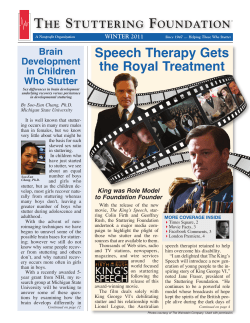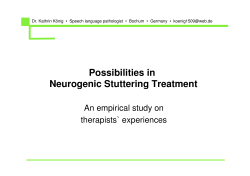
The Truth Behind Stuttering
The Truth Behind Stuttering A seminar on the misconceptions, identification, treatment and management of fluency. The UQ fluency clinic effectively treats children and adults who have a stutter. This seminar will look at what stuttering is and the treatment options available for someone who stutters. We will debunk some myths about stuttering and present effective ways to manage fluency. Presented by: Amber Brooker, Emily Doherty, Rachael Dwyer, Bonnie Hayes, Alison King, Jennifer Smith and Pip Thompson Famous Stutterers Winston Churchill Anthony Hopkins Marilyn Monroe Emily Blunt Albert Einstein Bruce Willis Famous Stutterers Lewis Carroll King George VI Nicole Kidman Sam Neill Myths about Stuttering True or False? Stuttering can be “caught” through imitation or by hearing another person stutter True or False? Nervousness and stress causes stuttering. True or False? Singing can make a stuttering person temporarily fluent True or False? Forcing a left-handed child to become right-handed causes stuttering True or False? Stuttering is a normal part of children’s speech development True or False? Males are twice as likely to stutter as females True or False? I should finish a person’s sentence if they are stuttering. What is Stuttering? Stuttering is a disorder in the rhythm, timing, and coordination of speech such that the person knows exactly what they want to say, but at the time is unable to move forward in their speech due to involuntary repetitions, blocking or prolongations of sounds or words (WHOICD, 1977). Reference? What are Stuttering Behaviours? Core Stuttering Behaviours Repetitions Of individual sounds, syllables or whole words Prolongations I Stretching out of a sound or syllable fffffound a book I fffffffound a book Blocking The airflow is physically stopped. *I found *I found a book a book I found found found a book What are Stuttering Behaviours? ‘er’ ‘um’ ‘sort of’ Secondary Stuttering Behaviours Verbal Behaviours Interjections Interjection of extraneous sounds, syllables, words, or phrases at an inappropriate point in the utterance I found I found • Restarts a book Involve two or more words which are repeated unchanged. I found Revisions I got Involve two or more words which are a book repeated but changed in some way What are Stuttering Behaviours? Non-Verbal Behaviours Word Avoidance Facial Contortions Loss of Eye Contact Associated Body Movements Sheehan's Iceberg of Stuttering Stuttering is the only part of the problem we can see but there is much more below the surface. [Sheehan, 1970] Ordering a coffee? Telling a joke? Can I get a C…C….C….CCCCoffee please? Why did the chicken cross the road? …T....T….T….TTTT….To get tttto the other side… Who is Affected? Approx. 1-2% adults and 4-5% children Same across all cultures, socio-economic groups and levels of education Gender Differences 1:2 ratio of females to males in childhood Girls tend to recover more quickly and are more likely to grow out of it Family Factors • 70-80% of people with a stutter have a known family history. • A child’s risk of stuttering is raised threefold by having a first degree relative who stutters. “Risk Factors” If a child has the following factors, treatment is recommended: – Gender (Male) – Age at onset (over 36 months) – Relatively poor speech and language skills – Anxiety behaviours. Age of Onset • Earliest gradual onset is 18months. • Average onset is 3 years (or between the ages of 2 and 5). Adult Onset: – Is usually due to acquired neurological damage or psychological trauma and conversion. – Can also develop around the time of puberty. Stuttering Treatment Lidcombe Program • Behavioural treatment for stuttering in preschool-age children. • A parent or significant person in the child's life delivers the treatment in the child's everyday environment. • The parent learns how to do this during weekly visits with the child to the speech clinic. • At the weekly clinic visits the Speech Pathologist monitors and adjusts the treatment to ensure that it is a positive and enjoyable experience for the child. • The Program is presented in two stages – (1) Reduction of Fluency and (2) Maintenance. Why does it work? • Parents have potent reinforcers for children. • Uses the common parenting principles of praise and reward. • No overlearning of stuttering – capitalises on neuroplasticity. • Treatment occurs where stuttering occurs (in home environment). [Packman et al., 2007] Therapy in adolescents and adults • Therapy is individualised and based on each client’s needs. • Therapy focuses on Increasing fluent behaviours and decreasing avoidance • For example: – We have adult clients who want to apply for jobs so therapy is very targeted to this. We have adolescent clients who get embarrassed talking up in class so we role play these situations and target therapy specifically to this. Smooth Speech • Retraining of the speech mechanism by modifying the way in which one usually breathes, voices, articulates or phrases to produce smooth unbroken speech. Smooth Speech promotes • Relaxation (mind and body) • Breathing - relaxed diaphragmatic • Gentle onsets • Gentle contacts • Continuous airflow • Continuous smooth movements • Natural sounding voice and prosody Cognitive Restructuring • Identifying faulty beliefs and anxieties and changing these to be more productive. • Evidence that cognitive restructuring can improve fluency outcomes: – When done in conjunction with speech restructuring – When done after a speech restructuring program. Good research evidence for cognitive-behavioural approaches, that incorporate smooth speech and cognitive restructuring. Where can you get help? • • • • • At UQ of course!! UQ Fluency Service for Paediatric and Adult. Student run and Private individual sessions Holiday intensive group programs Holiday Booster Programs Support for stutterers The roles of the Australian Speak Easy Association include; • to provide information about therapy options • to support people who stutter before, during and after therapy • to enable accessibility to state support groups and social functions • to encourage, facilitate and coordinate (in collaboration with Speech Pathology professionals) Community Education programmes about stuttering • There are groups located in Brisbane, Sunshine Coast and Gold Coast www.speakeasy.org.au For more information Contact UQ’s School of Health and Rehabilitation Sciences on (07) 3365 2232 Contact one of our Speech Pathology Fluency Specialists – Emma Bray via email on e.rees@uq.edu.au – Adriana Penman via email on a.penman1@uq.edu.au References • Sheehan, Joseph G. (1970.) STUTTERING: Research and Therapy. Harper and Row. NY • Jones, Onslow, Packman, Williams, Ormond, Schwarz & Gebski. (2005). Tandomised controlled trial of the lidcombe programme of early stuttering intervention. British Medical Journal, 331(7518), 659.
© Copyright 2025





















